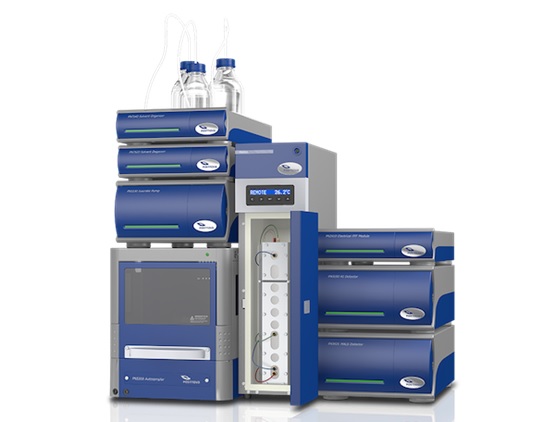Characterizing virus and virus-like particles

New application study describes the separation and characterisation of adeno associated virus serotypes by AF4.
In a new application study, Postnova Analytics reports that its latest generation of Asymmetrical Flow Field Flow Fractionation (AF4) systems are providing labs worldwide with a uniquely powerful technique to characterize and quantitate virus and virus-like particles.
Virus and virus-like particles are widely used in the healthcare industry for vaccination via immune response stimulation. Because these particles are to be injected into patients there is a critical requirement for a technique that allows detection and separation of the monomeric, oligomeric and aggregated species in a typical formulation.
Although Size Exclusion Chromatography (SEC) has been a traditional analytical technique used for this application it has significant limitations relating to the size exclusion limit of the separation column that restricts the upper molar mass and particle size range that can be measured.
By comparison, AF4 is an advanced separation technique that can address the problems associated with SEC. In AF4, an open, unpacked separation channel is used in place of a packed column. The absence of a stationary phase in AF4 systems results in the ability to use a wider range of solvents, elimination of SEC shear force and matrix interaction effects as well as the ability to separate particles over a very wide size range, from 1 nm up to above 1 µm. These capabilities enable AF4 to provide a complete picture of virus and virus-like particles including monomer content, insoluble and soluble aggregates, as well as the subvisible particle fraction.
Related News
-
News Patients vs Pharma – who will the Inflation Reduction Act affect the most?
The Inflation Reduction Act brought in by the Biden administration in 2022 aims to give better and more equitable access to healthcare in the USA. However, pharma companies are now concerned about the other potential costs of such legislation. -
News CPHI Podcast Series: What does the changing US Pharma market mean for industry and patients alike?
In this week's episode of the CPHI Podcast Series Lucy Chard, Digital Editor for CPHI Online is joined by James Manser to discuss the political and market changes in the US pharma field. -
News CPHI Barcelona Annual Report illuminates industry trends for 2024
The CPHI Annual Survey comes into it’s 7th year to report on the predicted trends for 2024. Over 250 pharma executives were asked 35 questions, with their answers informing the industry landscape for the next year, spanning all major pharma marke... -
News Which 10 drugs are open to price negotiation with Medicare in the USA?
The Centres for Medicare & Medicaid Services, under the Biden administration in the USA, has released a list of the 10 drugs that will be open to price negotiations as part of the new legislation under the Inflation Reduction Act (IRA). -
News EU Medical Devices Regulation causes unintended disappearances of medical devices for children, doctors state
Doctor groups and associations have appealed to the EU to correct the EU Medical Devices Regulation law that may cause unintended shortages of essential drug and medical devices for children and rare disease patients. -
News 10 Major Drug Approvals So Far in 2023
Last year, 37 novel drugs were approved by the FDA, this was a high number for such a category, and covered many fields including oncology, demonstrating how promising further research is, and how it is only continuing to build. To date, there are alre... -
News Detecting Alzheimer's disease with a simple lateral flow test
A novel rapid diagnostic test for early-stage Alzheimer's disease has been developed using a biomarker binder from Aptamer Group along with technology from Neuro-Bio, the neurodegenerative disease experts. -
News CPHI Podcast Series: outsourcing and manufacturing trends
Listen to the CPHI Podcast Series this June to hear Gil Roth of the PBOA speak with Digital Editor Lucy Chard about the biggest trends and topics to watch in pharma outsourcing and manufacturing at the minute.
Position your company at the heart of the global Pharma industry with a CPHI Online membership
-
Your products and solutions visible to thousands of visitors within the largest Pharma marketplace
-
Generate high-quality, engaged leads for your business, all year round
-
Promote your business as the industry’s thought-leader by hosting your reports, brochures and videos within your profile
-
Your company’s profile boosted at all participating CPHI events
-
An easy-to-use platform with a detailed dashboard showing your leads and performance







